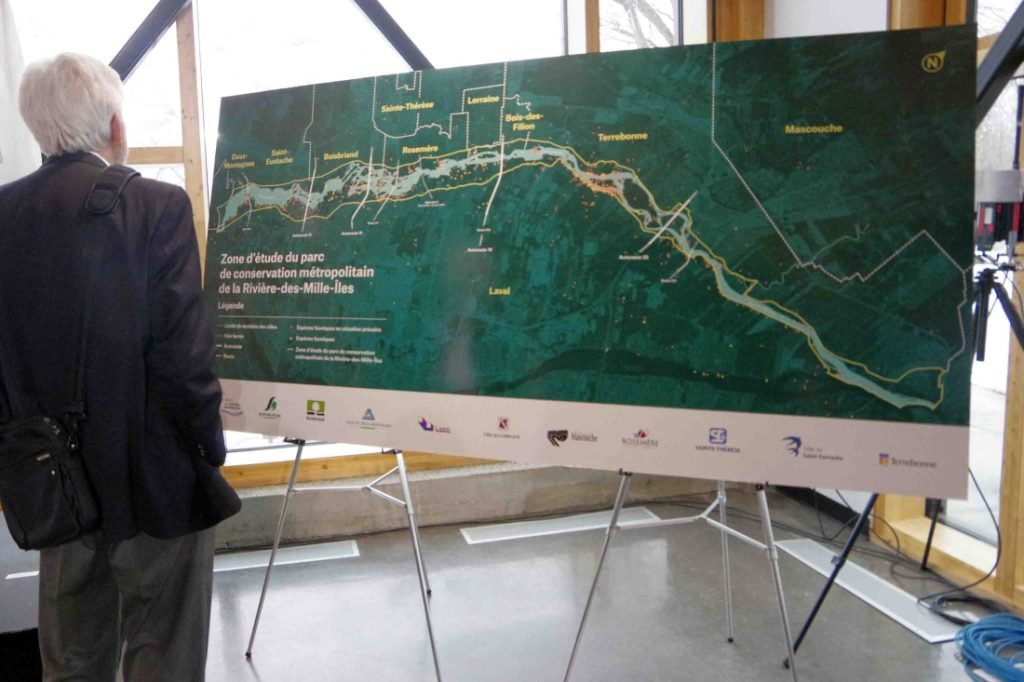42-kilometre green space will stretch from Deux-Montagnes to Mascouche
The City of Laval is one of 10 municipalities along the Mille Îles River that have agreed to create a massive waterfront linear park more than 40 kilometres in length to enlarge the amount of green space in the Montreal region, while also assuring ongoing access to clean drinking water.
Special status sought
Representatives of the municipalities, including Laval mayor Stéphane Boyer, gathered last week at the Parc de la Rivière-des-Mille-Îles in Sainte-Rose to announce they had signed a common declaration in which they pledged to do whatever is necessary to obtain a provincial statute enshrining a protected status for the future parkland by next year.

According to a statement issued by the mayors, the park will be a “mosaic” of protected spaces, including the Rivière-des-Mille-Îles nature sanctuary which is currently being studied for enlargement. The mayors want the future linear park to be recognized as a metropolitan conservation area, an idea which the provincial government seems already to support.
Fulfilling a pledge
“This is one of our electoral commitments that is coming together today,” said Mayor Boyer, who also sits on the Montreal Metropolitan Community’s executive-committee.

“In Laval, not only is it one of our priorities to project natural areas, but it is also our wish to further develop them so that citizens may be able to take advantage of them fully. I am proud of the collaborative work that was accomplished to bring together these spaces and manage them.”
Largest green space
It is estimated that the creation of the new parkland along the Mille Îles River could eventually include 5,000 hectares of territory. As such, it would become the largest protected space in the greater Montreal region, and would at the same time contribute to a Montreal Metropolitan Community goal to safeguard 30 per cent of the CMM’s wooded territory by the year 2030.
In addition to their commitment to cooperate on creating the park, the ten mayors also agreed to set up a regional concertation table for the Mille Îles River in order to ensure continuous financial support for the park, as well as ongoing efforts to obtain an official status.
‘A natural treasure’
The concertation table would include all the municipalities that have signed the declaration and would be presided by the Éco-Nature group. The provincial government and the CMM have also stated their commitment to working cooperatively with the table.

“The Mille Île River is a natural treasure of priceless value for Laval, and I am proud that our government is playing an important role in the protection of this exceptional sector,” said Sainte-Rose CAQ MNA Christopher Skeete who is the minister responsible for the Laval region in the Legault cabinet.
“The creation of the Mille Îles River concertation table demonstrates that more than ever we are listening to the people of Laval,” he added. “I would also like to emphasize the importance of bringing together the municipalities involved in this promising project for the region, without which it would not have happened.”
A biodiverse territory
“The Mille Îles River is a sector which is rich in biodiversity,” said Quebec Environment and Climate Change Minister Benoit Charette. “It includes numerous islands and shores with various natural areas, representing a wide diversity of animal habitats. Nearly a hundred of these species face precarious circumstances, notably as a result of the impact of human activity on their habitats.
“The government of Quebec is especially pleased with the creation of the regional concertation table,” said Charette. “It will become a place for in-depth reflection for the local partners to exchange ideas and collaborate on the project for the Mille Îles River nature conservation area.”
It is estimated that the creation of the new park could eventually include 5,000 hectares of territory
A boost for tourism
The Mille Îles River’s potential for generating more tourism from visitors seeking natural settings in the Montreal metropolitan region is considerable, said Caroline Proulx, the Minister of Tourism in the CAQ cabinet.
“Today’s announcement opens up enormous possibilities for the regions of Laval and the North Shore so that the river is discovered by all those from here and elsewhere who love the outdoors,” she said. “Our government will continue to be present alongside the shoreline municipalities and our partners in order to develop a range of tourist activities that respect nature.”



